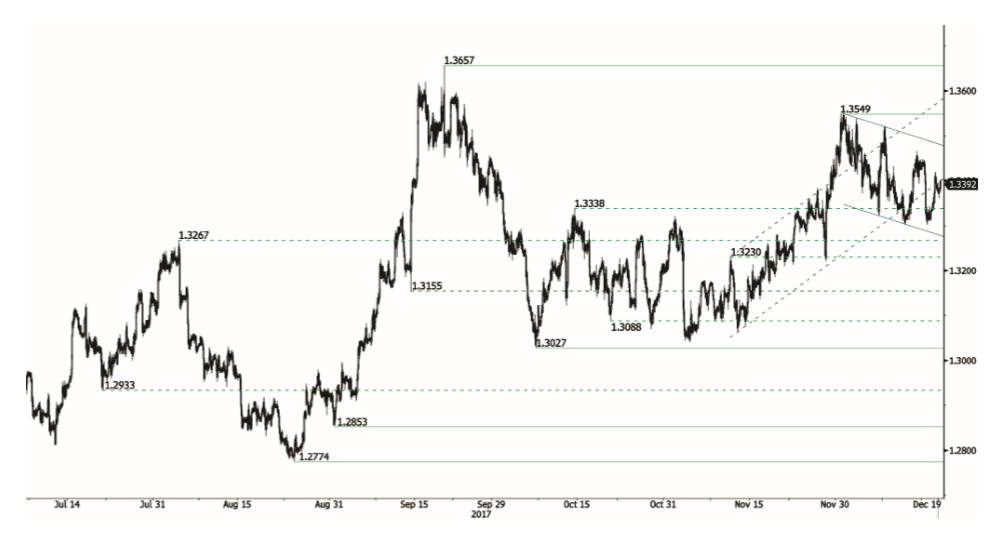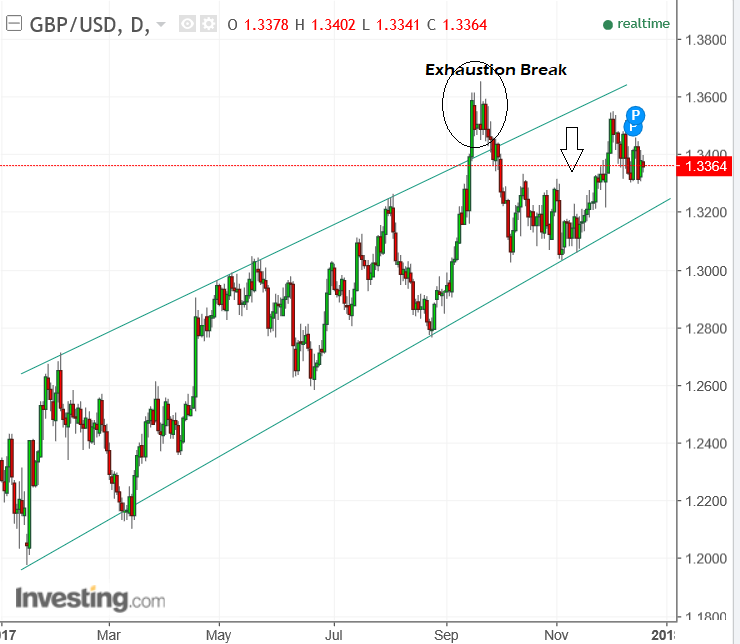Technical Analysis: Pound-to-Dollar Will Weaken Further, Below 1.33, Say Swissquote

Sterling is trading in a narrow range above 1.33 against the Dollar and most analysts are baffled by the extended sideways trend, but Swissquote analysts have a clear view.
The Pound-to-Dollar rate is going to weaken and, eventually, break below the key 1.33 level that has held firmly so far in December.
After peaking in late November, the pair has drifted lower to hit a marble floor between 1.3300 and 1.3350, from where it has oscillated sideways throughout recent weeks.
Chart levels tend to gain significance when tested over and over. This appears to have happened with the 1.3300-1.3350 zone for the Pound-to-Dollar.
The pair touched this level twice on the way up in October and then twice in December on the way back down. It's rare for a line of support or resistance to have been fortified by so many touches.
Given its strength, analysts are sceptical over whether it will break and have been calling the pair as more likely to rise away from it than it is to fall through it. But this is now changing.
Online trading firm, Swissquote, stands out as one of the few who are outright bearish in their predictions for the Pound-to-Dollar rate.
Eschewing an interpretation of a neutral and directionless outlook Yann Quellan, an analyst at Swissquote, says the pair is in a descending channel that is likely to see it move lower.
"GBP/USD continues to move lower within downtrend short-term channel. The technical structure indicates further weakness. Support is given at a distance at 1.3302 (15/12/2017 low)," Quellan writes in a note Tuesday.
"The long-term technical pattern is reversing. The Brexit vote had paved the way for further decline. Long-term support can be found at 1.1841 (07/10/2017 low)."

Above: Swissquote chart showing GBP/USD.
Taking a more cautious line, which is more representative of the broader analyst community, are strategists at Lloyds Banking Group.
"No change here. 1.3300 pivot support and 1.3550 reaction highs (set at the end of November) continue to contain price action. Further range trading over the coming sessions is most likely," says Robin Wilkin, a cross-asset strategist at Lloyds.
Recently quite bullish, Commerzbank’s technical strategist is now more neutral.
GBP/USD’s intraday Elliott wave counts are conflicting. We are unable to rule out a small rebound to the 1.3550 December high,” says Karen Jones, a technical analyst at Commerzbank.
“1.3300 continues to hold, [a move] below here will be needed to alleviate immediate upside pressure and allow for weakness back to the 1.3184 2016-2017 uptrend.”
Elliot Waves are a form of cycle analysis that is normally quite helpful in pointing the way to the next directional move but, as Jones notes, they’re quite conflicted at the moment.
On the one hand, the Pound-to-Dollar pair has broken above a major trendline drawn from the 2014 highs, suggesting an important bullish development is underway.
"However the break higher has not exactly been dynamic and we are having our doubts that this is a valid break," Jones writes, in her morning briefing Tuesday.
Richard Perry, an analyst at Hantec Markets, is equally neutral in his assessment of the outlook for GBP/USD.
"Another contradictory candle was posted yesterday as sterling rebounded again. This continues the recent run of mixed signals that are showing on Cable as the lack of trend with a sideways shift sees the market being squeezed between the resistance of a recent two-week downtrend and the support at $1.3300."

Above: Hantec Markets chart showing GBp/USD
Pound Sterling Live: Exhaustion Break
One chart feature we have noticed on GBP/USD, which reinforces the bearish call is the exhaustion break which occurred at the November highs (see chart below).
This happens when the exchange rate is channeling higher and then suddenly accelerates and breaks out above the upper border of the channel, before peaking and then declining.
It is usually a longer-term sign of weakness so we were quite surprised to see the pair recover at the start of November, however, recover it did. The pair climbed back up to the 1.35s again during the process.
Nevertheless, the exhaustion break leaves a legacy that haunts the chart with a negative look-and-feel that we cannot completely ignore.

Get up to 5% more foreign exchange by using a specialist provider by getting closer to the real market rate and avoid the gaping spreads charged by your bank for international payments. Learn more here.










